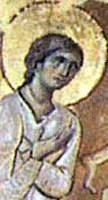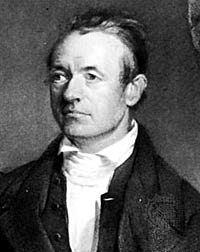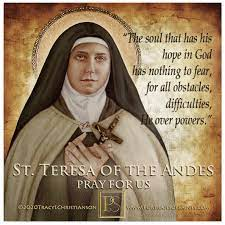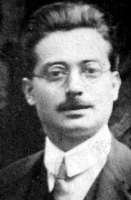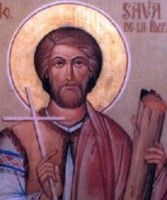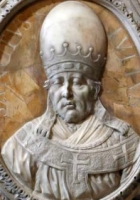Saint Margaret of Castello
அருளாளர்_மார்கரெட் (1287-1320)
ஏப்ரல் 13
இவர் (#BlMargaretOfCastello) இத்தாலியில் பிறந்தவர்.
பிறவியிலேயே பார்வையற்றவராகவும், உடல் ஊனமுற்றவராகவும் கூன் விழுந்தவராகவும் பிறந்த இவரை, இவரது பெற்றோர் ஒவ்வொரு நாளும் திருப்பலி காணும் வகையில், தாங்கள் இருந்த இடத்தின் அருகிலிருந்த கோயிலுக்குப் பின்னால் வைத்து வளர்த்து வந்தனர்.
14 ஆண்டுகள் கழித்து, இவர் நலம்பெறுவதற்காக இவரது பெற்றோர் இவரை ஒரு திருத்தலத்திற்குக் கொண்டு சென்றார்கள். அங்கு இவரது பெற்றோர் இவர் நலம் பெற வேண்டும் என்று தொடர்ந்து மன்றாடினார்கள். இவர் நலம் பெறாததால் அவர்கள் இவரை அங்கேயே விட்டு விட்டுச் சென்றனர். இதனால் இவர் திருத்தலத்திலேயே இருந்து, இறைவேண்டலில் நிலைத்திருந்தார்.
இவர் பொதுநிலையினருக்கான தோமினிக்கன் துறவு அவையில் சேர்ந்து தன்னால் இயன்ற நன்மைகளை ஏழை எளிய மக்களுக்குச் செய்தார்.
இப்படியே இவரது வாழ்க்கை சென்று கொண்டிருக்க இவர் 1320 ஆம் ஆண்டு இறையடி சேர்ந்தார். இவர் இறந்த பிறகு இவரது உடலைக் கோயிலுக்குள் உள்ள கல்லறையில் அடக்கம் செய்யக்கூடாது என்று கோயில் நிர்வாகிகள் ஒருசிலர் தடுத்தனர். அப்பொழுது உடல் ஊனமுற்ற ஒருவர் இவரிடம் வேண்டியதால் நலம் அடைந்ததும், இவரைக் கோயிலுக்குள் இருந்த கல்லறையில் அடக்கம் செய்தார்கள்.
இவருக்கு 1609 ஆம் ஆண்டு திருத்தந்தை ஐந்தாம் பவுலால் அருளாளர் பட்டம் கொடுக்கப்பட்டது.
Also known as
• Margaret of Citta-di-Castello
• Margaret of Metola
Profile
Born a blind, lame, deformed, hunchback midget. When she was six years old, her noble parents walled her up beside a chapel; she could not get out, but could attend Mass and receive the Sacraments. After 14 years of imprisonment, her parents took her to a shrine to pray for a cure. When none occurred, they abandoned her. She became a lay Dominican, and spent her life in prayer and charity. When she died, the townspeople thronged her funeral, and demanded she be buried in a tomb inside the church. The priest protested, but a crippled girl was miraculously cured at the funeral, and he consented.
Born
1287 at Mercatello sul Metauro, Pesaro-Urbino, Italy
Died
• 13 April 1320 in Città di Castello, Perugia, Italy of natural causes
• body incorrupt
Beatified
19 October 1609 by Pope Paul V (concession of indult for Mass and Office)
Canonized
24 April 2021 by Pope Francis (equipollent canonization)
Saint Hermengild
Also known as
Ermengild, Ermengildo, Hermenegild
Profile
Son of the Spanish Visigoth Arian king Levigild, and raised in Arianism. In 579 he married the Catholic princess Indgund, who, with Saint Leander, bishop of Seville, Spain, converted him back to orthodox Christianity. Immediately disinherited by his father.
Publicly renounced and fought against Arianism; he expected support from outside anti-Arian groups, but it never materialized, and he was defeated by his father's forces. King of Seville. At one point he reconciled with his father, but his step-mother, Goswintha, caused friction between them because of her staunch Arian views. Arrested, tortured, and martyred on orders of his father for refusing to denounce Catholicism and refusing to accept communion from a heretic bishop.
Died
• tortured and axed to death 13 April 585
• relics at Seville, Spain
Canonized
1585
Saint Caradoc of Wales
Also known as
Caradog, Caractacus, Caradocus, Caradoco
Profile
Born to a wealthy family, Caradoc spent part of his youth as a harp player in the court of King Rhys ap Twedwr of South Wales. He fell out of royal favour when he lost one of the king's greyhounds. Deciding to start a new life, Caradoc broke the tip of his spear to turn it into a walking stick, and left the court to become a monk at Saint Teilo church. Longing for a quieter life, he became a hermit in the ruins of Saint Kyned church in Gower where he was known to befriend wild animals. Ordained in Menevia, Wales. With several companions he set up a hermitage on Barry Island off the coast of Wales. After surviving Viking raiders, the hermits were driven from the island by King Henry I of England. Caradoc spent the rest of his days as a prayerful hermit in a cell in modern Haroldston, Pembrokeshire. Church Lawrenny in Pembrokeshire is dedicated to him.
Born
11th century Brycheiniog, Wales
Died
• 13 April 1124 at Saint Isells, Wales of natural causes
• interred at the cathedral of Saint David
• re-interred several years later, and body found incorrupt
• the historian William of Malmesbury tried to cut off a finger to take as a relic; Caradoc's hand jerked away
Saint Sabas Reyes Salazar
Also known as
Sabas Reyes
Additional Memorial
21 May as one of the Martyrs of the Mexican Revolution
Profile
Seminarian at Guadalajara, Mexico. Ordained in the diocese of Taumalipus, Mexico in 1911. Worked in several parishes in Guadalupe. Sent to Tototlan, Mexico to escape the government's persection of the Church and its priests.
In January 1927 government troops commandeered his church; they smashed images, burned statues, and used the building as a stable. Father Sabas's parishioners told him to escape, but he said God had placed him there for a reason, and that they should pray for divine help against the soldiers.
On 11 April 1927, just as he finished a baptism in a private home, federal troops broke in to arrest him. Over the next two days he was severely beaten, burned, and tortured as the troops tried to learn the hiding places of other priests; he told his captors nothing. Martyr.
Born
5 December 1883 in Cocula, Jalisco, Mexico
Died
shot at 9pm on 13 April 1927 in a cemetery outside Tototlan, Jalisco, Mexico
Canonized
21 May 2000 by Pope John Paul II during the Jubilee of Mexico
Pope Saint Martin I
புனிதர் முதலாம் மார்ட்டின்
74வது திருத்தந்தை/ மறைசாட்சி:
ஏற்கும் சமயம்:
ரோமன் கத்தோலிக்க திருச்சபை
கிழக்கு மரபுவழி திருச்சபை
பிறப்பு: ஜூன் 21, 598
டோடி, உம்பிரியா, பைஸண்டைன் பேரரசு
இறப்பு: செப்டம்பர் 16, 655
செர்சொன், பைஸண்டைன் பேரரசு
திருத்தந்தை முதலாம் மார்ட்டின், கத்தோலிக்க திருச்சபையின் 74வது திருத்தந்தையாக 649ம் ஆண்டு, ஜூலை மாதம், 21ம் தேதிமுதல் 655ம் ஆண்டில் தனது இறப்புவரை ஆட்சி செய்தவர் ஆவார்.
இவர், “பைஸண்டைன் பேரரசின்” (Byzantine Empire) “ஊம்ப்ரியா” (Umbria) மாகாணத்திலுள்ள “டோடி” (Todi) எனும் நகரில் பிறந்தார். “திருத்தந்தை முதலாம் தியடோருக்குப்” (Pope Theodore I) பிறகு, 649ம் ஆண்டு, ஜூலை மாதம், ஐந்தாம் நாளன்று இவர் திருத்தந்தையானார். பைஸன்டைன் (Byzantine Papacy) திருத்தந்தை ஆட்சி காலத்தின்போது, அப்போதைய "காண்ஸ்டன்டினோபில்" (Constantinople) அரசரிடம் ஒப்புதல் பெறாமல் திருத்தந்தையானவர் இவர் ஒருவரே. இவரை "பேரரசர் இரண்டாம் கான்ஸ்டன்ஸ்" (Emperor Constans II) நாடுகடத்தினார். இவர் “தென்கிரீமியா” (Southern Crimea) மாகாணத்திலுள்ள “செர்சொன்” (Cherson) எனுமிடத்தில் இறந்தார். இவரை மறைசாட்சியாகவும், புனிதராகவும் கத்தோலிக்கம் மற்றும் கிழக்கு மரபுவழி திருச்சபைகள் ஏற்கின்றன.
இவர் திருத்தந்தையான பின்பு, முதல் வேலையாக “மொனொதிலிடிசம்” (Monothelitism) என்னும் கொள்கையினைக் குறித்து விவாதித்து முடிவெடுப்பதற்காக, 649ம் ஆண்டு, “இலாத்தரன்” பொதுச் சங்கத்தினை (Lateran Council of 649) கூட்டினார். இலாத்தரன் யோவான் பேராலயத்தில் (Church of St. John Lateran) கூடிய இக்கூட்டத்தில் 105 ஆயர்கள் கலந்து கொண்டனர். இது ஐந்து அமர்வுகளில் 5 அக்டோபர் முதல் 31 அக்டோபர் 649ம் ஆண்டுவரை நடந்தது. இதில் 20 சட்டங்கள் வெளியிடப்பட்டன. அவை மொனொதிலிடிசம் கொள்கையினை திரிபுக்கொள்கை என அறிக்கையிட்டது.
மார்ட்டின் இச்சங்கத்தின் முடிவுகளை சுற்றுமடலாக வெளியிட்டார். இத்திரிபுக் கொள்கையினரான "பேரரசர் இரண்டாம் கான்ஸ்டன்ஸ்" (Emperor Constans II), இவரை கைது செய்ய ஆணையிட்டார். 653ம் ஆண்டு, ஜூன் மாதம், 17ம் நாளன்று, கைது செய்யப்பட்டு, அதே ஆண்டு, செப்டம்பர் மாதம், 17ம் நாளன்று, காண்ஸ்டன்டினோபிளுக்கு அழைத்துச்செல்லப்பட்டார். அங்கிருந்து பைசாந்தியப் பேரரசின் செர்சனுக்கு (தற்போதைய கிரிமியா) நாடு கடத்தப்பட்ட்டார். கி.பி. 655ம் ஆண்டு, மே மாதம், 15ம் நாளன்று, அங்கு வந்த அவர், அதே ஆண்டு, செப்டம்பர் மாதம், 16ம் நாளன்று உயிர் நீத்தார்.
இவர் மறைசாட்சியாக மரித்த திருத்தந்தையர்களில் கடைசியானவர். காலங்காலமாக பின்பற்றி வரும் கத்தோலிக்க விசுவாசத்தை உயிரைக் கொடுத்து பாதுகாத்தவர்.
காண்ஸ்டன்டினோபிளுக்கு திருத்தந்தையின் தூதுவராக பணியாற்றிக் கொண்டிருக்கும்போது, பாப்பரசராக தேர்ந்தெடுக்கப்பட்டார். திருத்தந்தையான பிறகு பல்வேறு விதமான பிரச்சினைகளை சந்தித்தார். அந்நாட்களில், திருச்சபையில் ஒரு குழப்பம் உண்டானது.
"கிறிஸ்துவிடம் இரு தன்மையா - அல்லது ஒரு தன்மை உண்டா" - என்ற வாதம் எழுந்தது. கிறிஸ்துவிடம் மனிதத் தன்மை மட்டுமே உண்டு என்ற தவறான கருத்துக்கு அடிமையாக இருந்த இரண்டாம் கான்ஸ்டான்ஸ் அரசன், இதையே அறிவிப்புச் செய்ய வேண்டுமென்று திருத்தந்தையைக் கேட்டுத் தொல்லை செய்தான். இதனால் திருத்தந்தை முதலாம் மார்ட்டின் 649ல் ரோமில் விரைவாக லாத்தரன் பொதுச் சங்கத்தைக் கூட்டினார். இச்சங்கத்தின் முடிவில், கிறிஸ்துவில் இரண்டு தன்மைகள் உண்டு என்ற மிகத்தெளிவான முடிவை லாத்ரன் பொது சங்கம் அறிவித்தது.
இதன் விளைவாக, மார்ட்டின் கான்ஸ்டைன்ஸ் மன்னரால் 653ல் கைதியாக கெர்சோன் என்ற இடத்தில் சிறைப்படுத்தப்பட்டார். திருத்தந்தைக்குரிய அடையாளங்கள் அனைத்தையும் அரசன் வெளிப்படையாகவே பறித்துக் கொண்டான்.
திருத்தந்தை பலவிதமான கொடுமைகளுக்கு ஆளாக்கப்பட்டு, பட்டினியாக விடப்பட்டார். "எனக்கு அறிமுகமானவர்கள் கூட எனது இடுக்கண் வேளையில் என்னை மறந்துவிட்டனர். நான் இன்னும் உயிரோடிருக்கிறேனா, செத்து மடிந்துவிட்டேனா என்று பார்க்கக்கூட யாருமில்லை. இருப்பினும் எல்லா மனிதரும் மீட்படைய வேண்டுமென்று விரும்பும் எல்லாம் வல்ல கடவுள், புனித பேதுருவின் வேண்டுதலால் அனைவரும் கத்தோலிக்க விசுவாசத்தில் நிலைத்து நிற்க அருள்புரிவாராக" என்று திருத்தந்தை மார்ட்டின் அடிக்கடி கூறிக் கொண்டே இருந்தார். இறுதியாக, கிரிமியாத் தீவில் உள்ள செர்சொனுக்கு நாடுகடத்தப்பட்ட இவர், கி.பி. 655ம் ஆண்டு, செப்டம்பர் மாதம், 16ம் நாளன்று, இறந்தார்.
Profile
Chosen 74th pope in 649 without imperial approval. Conducted the Lateran Council which condemned the patriach of Constantinople for Monothelitism, which claimed that Christ had no human will. This put him in opposition to the emperor who had him arrested and tortured. Paul, Patriarch of Constantinople, repented of his stance which saved Martin from execution, but the pope died soon after from damage done during his imprisonment, and is considered a martyr, the last martyred pope.
Born
at Todi, Tuscany, Italy
Papal Ascension
649
Died
655 at Cherson, Crimea (in modern Ukraine) from starvation
Blessed Rolando Rivi
Profile
Born to a farm family. Seminarian in the diocese of Reggio Emilia-Guastalla, Italy with a plan to become a missionary priest. Abducted, abused and tortured for three days, and then murdered by Communist partisans for being a Christian. Martyr.
Born
7 January 1931 in San Valentino di Castellarano, Reggio Emilia, Italy
Died
• shot on 13 April 1945 in a wooded area near Piani di Monchio, Modena, Italy
• buried in Piani di Monchio
• re-interred in the graveyard of his parish church of Saint Valentine on 29 May 1945
• re-interred in the church of Saint Valentine on 26 June 1997
Beatified
• 5 October 2013 by Pope Francis
• beatification recognition celebrated in Modena, Italy by Cardinal Angelo Amato
Blessed Scubilion Rousseau
Also known as
• Brother Scubilionis
• Jean Bernard Rousseau
Profile
A pious young man who served as a catechist. Entered the Christian Brothers' noviate in Paris, France on 24 December 1822, taking the name Scubilion Elementary school teacher for ten years in various locations in France. In 1833 he was assigned to teach and work with slaves on Reunion Island in the Indian Ocean; he spent 34 years there. He modified the lessons to suit the natives, started classes for them at night, worked with local priests, and brought many to the faith by his example of Christian life.
Born
21 March 1797 in Annay la-Côte, Burgundy, France as Jean Bernard Rousseau
Died
13 April 1867 on Reunion Island of natural causes
Beatified
2 May 1989 by Pope John Paul II
Blessed Albertinus of Fonte Avellana
Also known as
• Albertinus of Montone
• Albertino
Profile
Benedictine monk at Fonte Avellana monastery in Serra Sant'Abbondio, Italy. When his congregation merged with the Camaldolese in 1270, Albertinus was chosen prior-general. Peacemeaker between Gubbio and his flock. Refused to accept election as bishop of Osimo, Italy.
Born
mid 13th-century in Montone, Italy
Died
• 13 April 1294 of natural causes
• his grave became a site of miracles
Beatified
Pope Pius VI (cultus confirmed)
Saint Ursus of Ravenna
Also known as
Orso, Ours
Profile
Born to the Sicilian nobility. Convert to Christianity. His father violently opposed the conversion, and Ursus fled to Ravenna, Italy. There he so impressed the locals with his holiness that he became bishop of Ravenna for 20 years, reviving the celebration of the feasts of the saints, a custom that had fallen away.
Died
396 of natural causes
Blessed James of Certaldo
Also known as
Jacopo Guidi
Profile
Son of a knight of Volterra (in modern Italy). Camaldolese Benedictine monk for over sixty years at the abbey of Saint Clement and Saint Justus at Volterra, forty of which he served as parish priest at the abbey church. His father and brother became lay-brothers of the same abbey. Twice refused the abbacy, he finally took the position - then resigned to return to pastoral work.
Born
at Certaldo, Italy as Jacopo Guidi
Died
1292 of natural causes
Saint Ida of Boulogne
Also known as
Ida of Lorraine
Profile
Daughter of Duke Godfrey IV of Lorraine. Descendent of Blessed Charlemagne. Married Count Eustace II of Boulogne at age 17. Mother of Godfrey and Baldwin de Bouillon. Widow. Endowed several monasteries in Picardy (part of modern France). Benedictine oblate.
Born
1040 in Ardennes, France
Died
13 April 1113 of natural causes
Blessed John Lockwood
Also known as
John Lascellas
Additional Memorial
29 October as one of the Martyrs of Douai
Profile
Studied for the priesthood in Rome, Italy during the persecution of Catholics in England. Ordained in 1597. Worked covertly in England until his arrest in 1642. Martyr.
Born
1561 at Sowerby, Yorkshire, England
Died
hanged, drawn, and quartered on 13 April 1642 at York, England
Beatified
15 December 1929 by Pope Pius XI
Blessed Edward Catherick
Additional Memorial
29 October as one of the Martyrs of Douai
Profile
Studied at Douai, France. Priest. Returned to England in 1635 to minister to covert Catholics during a period of persecution by King Charles I. Martyr.
Born
Carlton, Country Durham, England
Died
hanged, drawn, and quartered on 13 April 1642 at York, England
Beatified
15 December 1929 by Pope Pius XI
Blessed Francis Dickenson
Also known as
Francis Dicconson
Profile
Studied at the English Seminary in Rheims, France. Priest, returning to England to minister to covert Catholics during a period of persecution by Queen Elizabeth I. Martyr.
Born
Otley, West Yorkshire, England
Died
13 April 1590 in Rochester, Kent, England
Beatified
15 December 1929 by Pope Pius XI
Blessed Miles Gerard
Profile
Studied at the English Seminary in Rheims, France. Priest, returning to England to minister to covert Catholics during a period of persecution by Queen Elizabeth I. Martyr.
Born
Ince, Lancashire, England
Died
13 April 1590 in Rochester, Kent, England
Beatified
15 December 1929 by Pope Pius XI
Blessed Isabel Calduch Rovira
Profile
Franciscan Capuchin Poor Clare nun. Martyred in the Spanish Civil War.
Born
9 May 1882 in Alcalá de Chivert, Castellón, Spain
Died
13 April 1937 in Cuevas de Vinromá, Castellón, Spain
Beatified
11 March 2001 by Pope John Paul II
Saint Agathonica of Pergamus
Also known as
Agatonica
Profile
Sister of Saint Papylus of Pergamus. Martyred in the persecutions of Decius.
Died
c.250 at Pergamus, Asia Minor
Saint Papylus of Pergamus
Also known as
Papilo
Profile
Brother of Saint Agathonica of Pergamus. Deacon. Martyred in the persecutions of Decius.
Died
c.250 at Pergamus, Asia Minor
Saint Carpus of Pergamus
Also known as
Carpo
Profile
Bishop of Thyatira. Martyred in the persecutions of Decius.
Died
c.250 at Pergamus, Asia Minor
Saint Martius of Auvergne
Also known as
Marzio
Profile
Mountainside hermit. His reputation for holiness spread, and he attracted so many would-be students that he built a monastery for them.
Born
Auvergne, France
Died
c.530
Saint Agathodorus of Pergamus
Profile
Servant of Saint Papylus of Pergamus and Saint Agathonica of Pergamus. Martyred in the persecutions of Decius.
Died
c.250 at Pergamus, Asia Minor
Blessed Ida of Louvain
Profile
Cistercian Benedictine nun at Rossendael near Malines. Visionary.
Born
at Louvain, France
Died
c.1300
Saint Proculus of Terni
Profile
Bishop of Terni, Italy. Martyred in the persecutions of Maxentius.
Died
310
Saint Guinoc
Also known as
Guinoch, Guinochus, Winnoc, Guinoco
Profile
Bishop in Scotland. Commemorated in the Aberdeen Breviary.
Died
c.838
Martyrs of Dorostorum
Profile
A lector and two students martyred together in the persecutions of Diocletian - Dadas, Maximus and Quinctillianus.
Died
beheaded c.303 in Dorostorum, Lower Mysia (modern Sillistria, Bulgaria
Mochaemhog of Inis Caoin
Saint Mochaemhog of Inis Caoin is an Irish saint commemorated on April 13th. Here's what we know about him:
Location and Time Period: Based on available information, he was associated with Inis Caoin (anglicized as Inishkeen) in County Fermanagh, Ireland. Unfortunately, there aren't specific details about when he lived.
Role: He was the abbot of a monastery located on the island of Inis Caoin.
Limited Information: Details about his life are scarce. There's no mention of extensive writings about him.
Serafino Morazzone
Serafino Morazzone was an Italian priest who was born in Milan in 1747 and died in Lecco in 1822. He was known for his piety, charity, and dedication to his flock. He was beatified by Pope Benedict XVI in 2011.
Early life and education
Serafino Morazzone was born on February 1, 1747, in Milan, Italy. He was the seventh of eight children born to Francesco Morazzone and his wife, Anna Maria Ciserani. His father was a grain merchant.
Serafino attended the Collegio di Brera, a Jesuit school in Milan. He then studied theology at the Seminary of Milan. He was ordained a priest on May 9, 1774.
Priestly ministry
After his ordination, Serafino Morazzone was appointed as an assistant pastor at the Church of San Giovanni Battista in Lecco. He served in this position for 10 years.
In 1784, Serafino Morazzone was appointed as the pastor of the Church of San Bartolomeo in Chiuso, a small village near Lecco. He served in this position for 38 years.
Serafino Morazzone was a dedicated and compassionate pastor. He was known for his piety, charity, and his love for the poor. He was also a gifted preacher and catechist.
Death and beatification
Serafino Morazzone died on April 13, 1822, at the age of 75. He was buried in the Church of San Bartolomeo in Chiuso.
The cause for Serafino Morazzone's beatification was opened in 1940. He was declared Venerable by Pope John Paul II in 2007. He was beatified by Pope Benedict XVI on June 26, 2011.
Legacy
Serafino Morazzone is remembered as a model of priestly virtue. He is a patron saint of the poor and the sick.
His feast day is celebrated on April 13.









